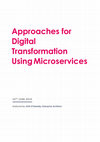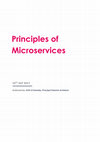Papers by Arlin D'Almeida
Telecom Operators are slow to adopt artificial intelligence into mainstream operations. It is cur... more Telecom Operators are slow to adopt artificial intelligence into mainstream operations. It is currently used mainly for reactive business insights. This paper identifies the reason for slow adoption of AI in the telecom industry, the top 5 use cases and proposes a reference architecture to enable mainstream adoption.
Telecom Operators are slow to adopt artificial intelligence into mainstream operations. It is cur... more Telecom Operators are slow to adopt artificial intelligence into mainstream operations. It is currently used mainly for reactive business insights. This paper identifies the reason for slow adoption of AI in the telecom industry, the top 5 use cases and proposes a reference architecture to enable mainstream adoption.

There are multiple strategies to transform a system estate into an estate that is faster to deliv... more There are multiple strategies to transform a system estate into an estate that is faster to deliver new features, easy to maintain, cost-efficient and robust. Of the many architectural styles for digital transformation, the architectural style that is getting a lot of attention in recent years is 'Microservices’.
‘Microservices’ is essentially independently deployable fine-grain components. It is owned by a small team who are responsible for the design, development, deployment and operations of the component. However, Microservices has an inherent dichotomy. It strongly advocates fine-grain decomposition of business functions for better management of the function, but it introduces integration challenges.
A successful digital transformation with Microservices requires more focus on the holistic integration of the entire application ecosystem such that the system estate acts as a single cohesive unit and drive a cultural change within the organization.
This paper provides some high-level guidance on the digital transformation approaches using Microservices.
Microservices have an inherent dichotomy. It strongly advocates fine-grain decomposition of busin... more Microservices have an inherent dichotomy. It strongly advocates fine-grain decomposition of business functions for better management of the function, but it introduces integration challenges. Any successful digital transformation with Microservices must focus on the holistic integration of the entire application ecosystem such that the system estate acts as a single cohesive unit.

There are multiple strategies to transform a system estate into an estate that is faster to deliv... more There are multiple strategies to transform a system estate into an estate that is faster to deliver new features, easy to maintain, cost-efficient and robust. Of the many architectural styles for digital transformation, the architectural style that is getting a lot of attention in recent years is 'Microservices’. This style is not completely new; it is a type of distributed architecture that has evolved from component-based architecture and service orientated architecture. It can be viewed as a specialisation of the overall service orientated architecture paradigm.
‘Microservices’ is essentially independently deployable fine-grain components. It is owned by a small team who are responsible for the design, development, deployment and operations of the component. It builds on the service orientated architecture concept of loosely coupled business services that encapsulates functional, technical and implementation complexity to other services, and interact with the rest of the system estate by exposing a simple REST APIs. The paradigm shift from service-oriented architecture to Microservices is the change in focus from 'reusability' and ‘integration through a service bus’ to 'decoupling a complete business functionality’ with emphasis on the ‘complete ownership’ of the Microservice by a small team.











Uploads
Papers by Arlin D'Almeida
‘Microservices’ is essentially independently deployable fine-grain components. It is owned by a small team who are responsible for the design, development, deployment and operations of the component. However, Microservices has an inherent dichotomy. It strongly advocates fine-grain decomposition of business functions for better management of the function, but it introduces integration challenges.
A successful digital transformation with Microservices requires more focus on the holistic integration of the entire application ecosystem such that the system estate acts as a single cohesive unit and drive a cultural change within the organization.
This paper provides some high-level guidance on the digital transformation approaches using Microservices.
‘Microservices’ is essentially independently deployable fine-grain components. It is owned by a small team who are responsible for the design, development, deployment and operations of the component. It builds on the service orientated architecture concept of loosely coupled business services that encapsulates functional, technical and implementation complexity to other services, and interact with the rest of the system estate by exposing a simple REST APIs. The paradigm shift from service-oriented architecture to Microservices is the change in focus from 'reusability' and ‘integration through a service bus’ to 'decoupling a complete business functionality’ with emphasis on the ‘complete ownership’ of the Microservice by a small team.
‘Microservices’ is essentially independently deployable fine-grain components. It is owned by a small team who are responsible for the design, development, deployment and operations of the component. However, Microservices has an inherent dichotomy. It strongly advocates fine-grain decomposition of business functions for better management of the function, but it introduces integration challenges.
A successful digital transformation with Microservices requires more focus on the holistic integration of the entire application ecosystem such that the system estate acts as a single cohesive unit and drive a cultural change within the organization.
This paper provides some high-level guidance on the digital transformation approaches using Microservices.
‘Microservices’ is essentially independently deployable fine-grain components. It is owned by a small team who are responsible for the design, development, deployment and operations of the component. It builds on the service orientated architecture concept of loosely coupled business services that encapsulates functional, technical and implementation complexity to other services, and interact with the rest of the system estate by exposing a simple REST APIs. The paradigm shift from service-oriented architecture to Microservices is the change in focus from 'reusability' and ‘integration through a service bus’ to 'decoupling a complete business functionality’ with emphasis on the ‘complete ownership’ of the Microservice by a small team.